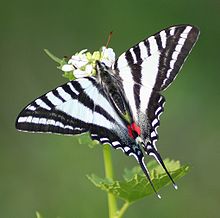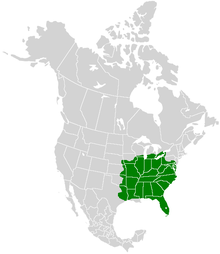Protographium marcellus
| Zebra swallowtail | |
|---|---|
 |
|
| Spring form | |
|
Not evaluated (IUCN 3.1)
|
|
| Scientific classification | |
| Kingdom: | Animalia |
| Phylum: | Arthropoda |
| Class: | Insecta |
| Order: | Lepidoptera |
| Family: | Papilionidae |
| Genus: | Protographium |
| Species: | P. marcellus |
| Binomial name | |
|
Protographium marcellus (Cramer, 1777) |
|
 |
|
| Synonyms | |
|
|
Protographium marcellus, the zebra swallowtail, (formerly listed under genera Eurytides, Iphiclides, Graphium and Papilio by some authorities) is a swallowtail butterfly native to the eastern United States and southeast Canada. Its distinctive wing shape and long tails make it easy to identify, and its black-and-white-striped pattern is reminiscent of a zebra. The butterflies are closely associated with pawpaws, and are rarely found far from these trees. The green or black caterpillars feed on the leaves of various pawpaw species, while the adults feed on flower nectar and minerals from damp soil.
The zebra swallowtail has a wingspan of 6.4 to 10.4 cm (2.5 to 4.1 in). The triangular wings are white to greenish white with black longitudinal stripes. A pair of swordlike tails extend from the hindwings. The inner margin of the hindwing has two blue spots on the corner and a red spot near the body. A red stripe runs along the middle of the ventral hindwing. P. marcellus has two seasonal forms, one occurring in the spring and the other in the summer. Spring forms are smaller, more white, and have short, black tails with white tips. Summer forms are larger, have broader black stripes, and longer, black tails with white edges.
The zebra swallowtail can be seen from late March to August in the northern portion of its range and from February to December in the southern portion. It has two broods in the north and three to four in the south, with the first brood being the most numerous.
Males will patrol near host plants in search of females, flying swiftly and directly. They usually fly 0.5 to 1.8 meters (2 to 6 ft) above the ground. Females will fly slowly when searching for suitable host plants. Both males and females avidly visit flowers, including species from the families Apocynaceae, Brassicaceae, Fabaceae, Lythraceae, Polemoniaceae, and Rosaceae. Males participate in a behavior known as puddling, in which individuals congregate on sand, gravel, or moist soil to obtain salts and amino acids. These nutrients aid the male in reproduction. Other food sources include rotting fruit and urine.
...
Wikipedia
